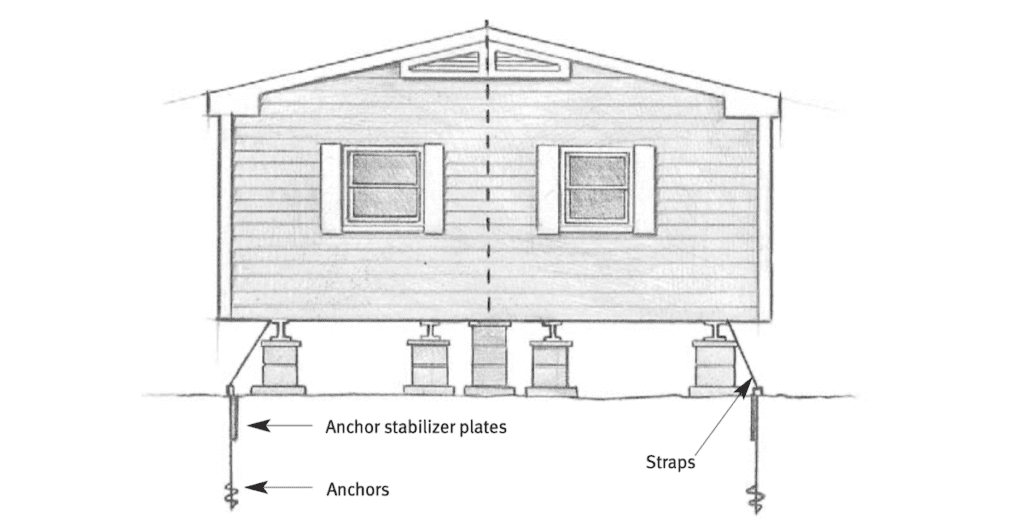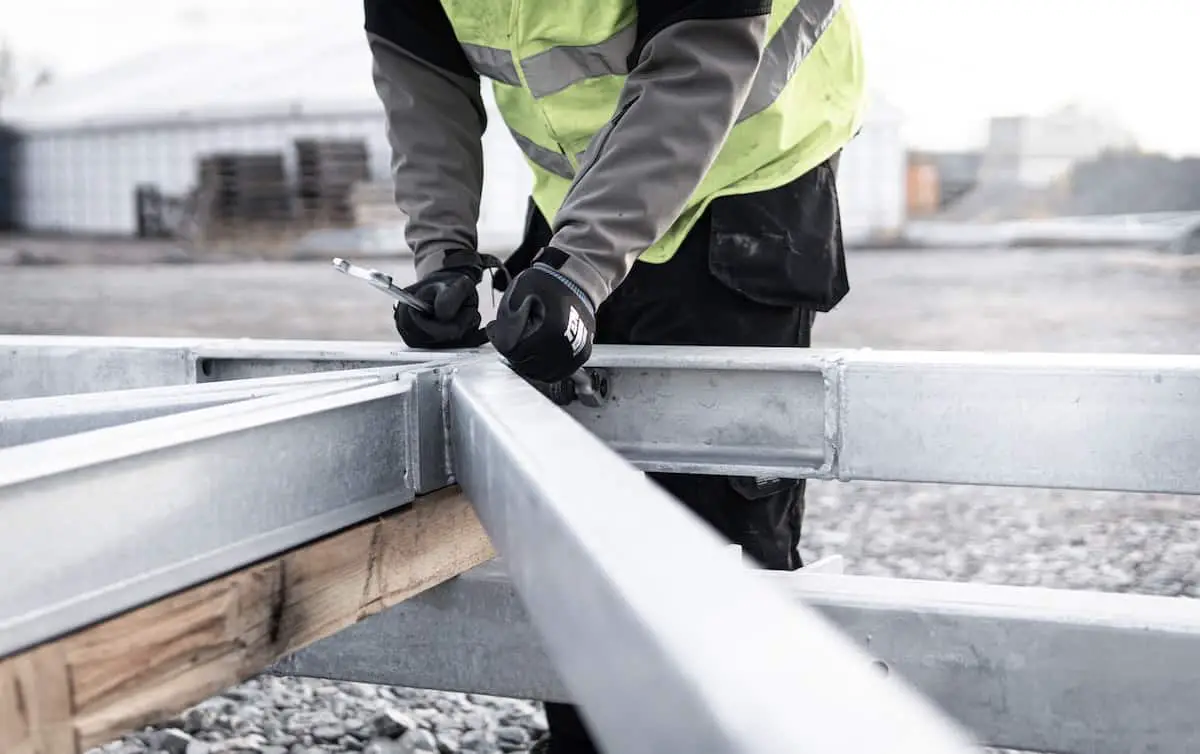Modular homes are always off-frame constructions, the only on-frame homes are those categorized as manufactured. These two types of homes are often mixed up given that both are prefabricated as three-dimensional sections. However, despite the apparent similarities shared between modular and manufactured homes, these are two very distinctive constructions.
Building on-frame means raising the whole house atop a permanent steel frame chassis designed to stabilize the house. This is a requirement for moveable constructions such as manufactured homes since they need some sort of structural base capable of holding the house during its transportation. Homes conceived as permanent constructions are built off-frame since they are attached to their permanent on-site foundation and once finished will never be moved again.
On-frame vs. off-frame:
| On-frame Homes | Off-frame Homes |
| Manufactured Homes | Mobile Homes |
The misunderstanding between these two can easily confuse you when buying a new house since even some manufactured homes are advertised as on-frame modular homes. Yet, when in doubt remember that manufactured homes are always built on-frame and modular homes are always off-frame.
Building Code Regulations: The difference between on-frame and off-frame homes
Every home built today is required to adhere to some sort of building regulation to ensure that the minimum standards of quality, durability, and affordability are met. Though these regulations differ between non-permanent and permanent constructions. Permanent constructions, such as modular homes are designed to be built in one specific plot of land where they will remain forever.
Therefore, they are required to adhere to the state, local or regional building codes. These codes vary depending on the state or region where the house is permanently placed, though they all follow the guidelines established by International Code Council® (ICC) [1]. The ICC doesn’t contemplate on-frame constructions and therefore, modular homes are never built on-frame.
Non-permanent constructions and therefore manufactured homes, can’t adhere to the state, local or regional building codes because they are mobile constructions designed to be installed anywhere rather than affixed to a permanent foundation in one single spot. Manufactured homes are then regulated at a national level by the Federal Manufactured Home Construction and Safety Standards, following the HUD Code [2]. The HUD Codes require all manufactured homes to be built on a steel frame chassis, which is to say on-frame.
On-frame Constructions: Manufactured Homes
As of today, the only type of construction that is built on a steel frame chassis is the manufactured home. Manufactured homes are the updated version of the old-style “mobile homes” and are therefore conceived as one unique volume that can be easily transported. Being built on-frame offers manufactured homes the stability they need once settled but also during transportation.
The most common type of foundation used for manufactured homes is the pier and ground anchor foundation which is non-permanent and very easy to install. Commonly these foundations are made of stacked hollow core concrete masonry blocks, placed for the steel frame chassis to sit on [3]. Since the manufactured home foundations are rarely conceived as a structural component of the house, the construction needs a strong structural base to stabilize it, which is exactly what the frame offers.

Certainly, manufactured homes are very often purchased as a substitute for a traditional house, being placed on a permanent foundation and once installed will remain in the same location for most of their life. However, despite the final intention of the owner, manufactured homes are always built on a steel frame chassis since it is a requirement defined in the HUD Codes [4].
This type of house is built in a factory-like environment up to completion, and once it leaves the manufacturing premises it is ready to be lived in. Therefore, it is most common for manufactured homes to be built as a whole in a single section and to limit their dimensions to the transportation needs with sizes of around 13.5 feet high, 80 feet long, and 18 feet wide [4].
On some occasions to extend the house’s surface, manufactured homes are built as multi-section constructions. Contrary to single-section manufactured homes, multi-section homes aren’t completely finished when they leave the manufacturing premises since they still require some on-site work to ensure the proper marriage of the different sections [5]. Still, these constructions are always considered manufactured homes and to comply with the HUD Codes, every section is constructed on its steel frame chassis.
The frame not only serves as a stabilizer but as the base of the trailer. Drilled to the I-beams that form the chassis is the tongue that will connect to the truck and the axles that will hold the wheels [6]. Thanks to the frame, the whole manufactured home unit can be easily pulled by a truck not only to leave the factory but any time in the future.
Off-frame Constructions: Modular Homes
Modular homes are permanent constructions that are built by putting several modules together. The modules are prefabricated sections of the house that similarly to manufactured homes are prefabricated in a factory-like environment. However, these modules are built off-frame since once they leave the manufacturing premises, every module is attached to permanent foundations and assembled with the other modules shaping the overall house.
The modules don’t need a frame to be stabilized because they are structural units by themselves. Moreover, the modules are only transported once: from the manufacturing premises to the building site. Therefore, they are transported on a removable steel frame, which has the sole purpose of holding the module while being pulled by a truck during its transportation.
Contrary to manufactured homes, the construction of a modular home isn’t finished once the modules leave the factory, and still, 20% of the house construction remains to be done on-site [7]. Some of these works consist of building permanent foundations and attaching the modules to them. Similar to a traditional on-site built home, a modular home is stabilized by its structure and foundations, in this case though, the structure is integrated into the prefabricated modules that once assembled will work as a whole.
Do not get confused: Modular homes are never on-frame
The confusion between manufactured and modular homes is very common and it is something you definitely don’t want to get caught on when purchasing a new home. In part because the Building Codes are in general, a guarantee of higher construction quality in comparison to the HUD Codes, though mainly because these two types of homes don’t receive the same title. A (real) modular home is always Real Estate Property, while a manufactured home is legally closer to a vehicle, receiving the title of Personal Property.
This is very important to keep in mind because it is possible to find manufactured homes labeled as “on-frame modular homes” even though in practice, they are still legally considered manufactured homes. These are often referred to as “hudular homes” which is a new term created to define a manufactured home of a higher quality because it is built up to both the HUD Codes as well as the local building codes [8]. However, hudular homes are still built on a frame and are therefore not considered modular nor permanent constructions, they still are legally tagged as manufactured homes.
When purchasing a home be clear about what kind of construction you want and always confirm with your modular or manufactured company if the home is built on a frame and to what building regulations is the house constructed.
References:
- I-Codes Code Adoption Map The Wagner Companies https://wagnercompanies.com/i-codes-code-adoption-map/
- (2015, 9 July) What you need to know about the HUD Code Home FirstTM https://homefirstcertified.com/what-you-need-to-know-about-the-hud-code/
- Manufactured Housing Research Alliance (2002, March 27) Guide to foundation and support systems for manufactured homes PATH (Partnership for Advancing Technology in Housing), New York, NYhttps://www.huduser.gov/portal/Publications/PDF/foundations_guide.pdf
- Frequently Asked Questions U.S. Department of Housing and Urban Development (HUD) https://www.hud.gov/program_offices/housing/rmra/mhs/faqs
- Federal Manufactured Housing Consensus Committee (2003, May 29) Model Manufactured Home Installation Standards U.S. Department of Housing and Urban Development (HUD) https://www.hud.gov/sites/documents/225HUD.PDF
- MindMule Acres (2020, 11 June) Moving a mobile home YouTube https://www.youtube.com/watch?v=hKKZ32CDh7Q
- Turn-Key and Custom Modular Homes West Built Homes https://www.westbuilt.com.au/turnkey-and-custom-modular-homes
- Herr A. (2014, 13 January) Manufactured homes vs. mobile homes vs. modular homes Hudular https://drewherr.wordpress.com/tag/hudular/
Figure 1. Manufactured Housing Research Alliance (2002, March 27) Guide to foundation and support systems for manufactured homes PATH (Partnership for Advancing Technology in Housing), New York, NYhttps://www.huduser.gov/portal/Publications/PDF/foundations_guide.pdf



